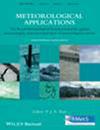Optimizing convection‐permitting ensemble via selection of the coarse ensemble driving members
IF 2.3
4区 地球科学
Q3 METEOROLOGY & ATMOSPHERIC SCIENCES
引用次数: 0
Abstract
Nowadays, several global ensembles (GEs) which consist of several tens of members are being run operationally. In order to locally improve the probabilistic forecasts, various forecasting centers and research institutes utilize the GEs as initial and boundary conditions to drive regional convection permitting ensembles (RCPEs). RCPEs demand significant computer resources and often a limited number of ensemble members is affordable, which is smaller than the size of the driving GE. Since each RCPE member obtains the initial and boundary conditions from a specific GE member, there are many options to select the GE members. The study uses the European Centre for Medium‐Range Weather Forecasts (ECMWF) GE consisting of 50 members, to drive 20 members of COSMO model RCPE over the Eastern Mediterranean. We compare various approaches for automatic selection of the GE members and propose several optimal methods, including a random selection, which consistently lead to a better performance of the driven RCPE. The comparison includes verification of near surface variables and precipitation using various verification metrics. The results are validated using several methods of model physics perturbation. Besides the selection of the optimal ensemble configurations, we show that at high precipitation intensities spatial up‐scaling is recommended in order to obtain useful probabilistic forecasts.优化对流-允许集合通过选择粗集合驱动成员
目前,几个由几十个成员组成的全局集成(ge)正在运行。为了局部提高预报的概率,各预报中心和研究机构利用GEs作为初始和边界条件来驱动区域对流容许集合(rcpe)。rcpe需要大量的计算机资源,而且通常有限数量的集成成员是负担得起的,这比驱动通用电气的规模要小。由于每个RCPE成员从特定的GE成员中获得初始条件和边界条件,因此有许多选择GE成员的选项。该研究利用由50个成员组成的欧洲中期天气预报中心(ECMWF) GE,驱动COSMO模型RCPE的20个成员在东地中海上空飞行。我们比较了自动选择GE成员的各种方法,并提出了几种最佳方法,包括随机选择,这些方法始终导致驱动RCPE的更好性能。比较包括使用各种验证度量对近地表变量和降水的验证。用几种模型物理摄动方法验证了结果。除了选择最优集合配置外,我们还表明,在高降水强度下,为了获得有用的概率预报,建议空间上尺度。
本文章由计算机程序翻译,如有差异,请以英文原文为准。
求助全文
约1分钟内获得全文
求助全文
来源期刊

Meteorological Applications
地学-气象与大气科学
CiteScore
5.70
自引率
3.70%
发文量
62
审稿时长
>12 weeks
期刊介绍:
The aim of Meteorological Applications is to serve the needs of applied meteorologists, forecasters and users of meteorological services by publishing papers on all aspects of meteorological science, including:
applications of meteorological, climatological, analytical and forecasting data, and their socio-economic benefits;
forecasting, warning and service delivery techniques and methods;
weather hazards, their analysis and prediction;
performance, verification and value of numerical models and forecasting services;
practical applications of ocean and climate models;
education and training.
 求助内容:
求助内容: 应助结果提醒方式:
应助结果提醒方式:


